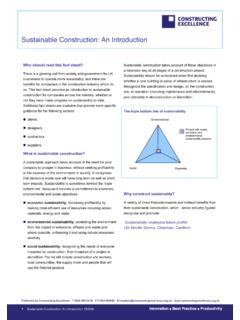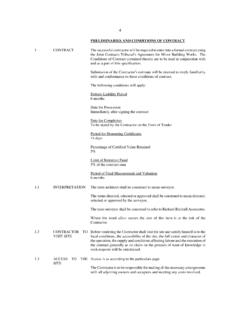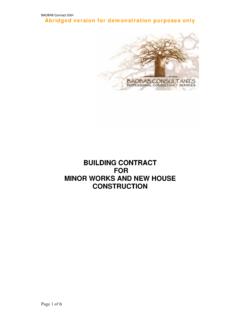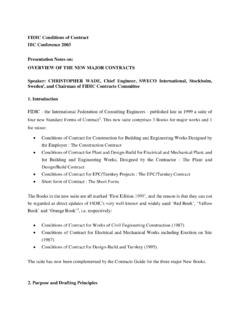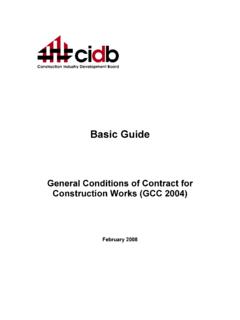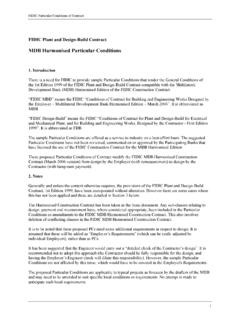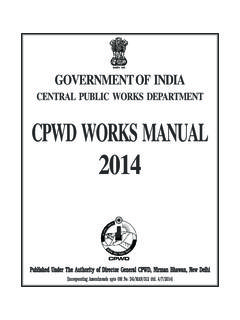Transcription of Construction Contract Standard forms of A Guide to
1 A Guide to Standard forms of Construction Contract Outlining Key Characteristics and ComponentsProduced for SCALA and the Local Government Task Force byRob Tate Dip Arch. Dip TP. Dip Arb. FCIArb. RIBA01582 516662 can contact the Local Government Task Force tel 020 7837 8286 or by visiting can contact SCALAtel 01446 771209 email or by visiting IntroductionThe most brilliant design remains just that, a design,unless turned into reality by building operations. Thoseoperations generally, and always in the public sectorcontext, require a formal agreement which sets out whodoes what for how much, how it should be done, andallocates the risk a Contract . The transition from asuccessful design to a successful building requires theselection of a Contract which reflects the aspirations ofthe Parties and meets the demands of the essential skill of a Contract Administrator is theselection and management of the building Contract .
2 For each project, key criteria must be considered andrisks allocated, before the form of Contract is selection can be made from a range of standardforms of Guide presents a list of the principal Standard formsof building Contract , highlighting significant features. It ispresented in a ready reckoner format as a primer forthe Contract selection process. As such it is notexhaustive and is not intended to be a sole source ofreference when selecting a Contract . It is a quickreference, a memory jogger, which suggests key criteriaand risks for consideration, with a broad comparativeanalysis as a start to the selection process. The Guide is presented in the form of a matrix. The centresection of the matrix sets out, in bar chart format, theallocation of risk and the weight ascribed to key criteriafor each Contract form. 23 ProcurementIn providing a concise primer for Contract selection, is not appropriate for this Guide to address the broaderissue of procurement.
3 It assumes an understanding ofprocurement and the routes available. However, the choice of Contract flows from theprocurement route chosen for the project. The choice of procurement route depends on the Client s requiredbalance of time/cost/quality and an analysis of how thatcan be achieved. This is in the context of the Client sother requirements, not least being his required level ofinvolvement in the design and Construction process andthe extent to which he may change his mind or wish toalter the specification during Construction . Those considerations promote a useful set of criteria for selection of the form of Contract . In this Guide eachcontract form is summarised in terms of the following key criteria: Speed - design and Construction Cost certainty Dealing with complexity Client s involvement Capacity for variations Clarity of remedies Separation of design and managementThe contracts included in this Guide cover the principalprocurement methods: General contracting Design and build Construction management Partnering Management contractingRiskThe formation of a Contract involves acceptance of anoffer, an intention to have a legally binding agreement,performance and payment.
4 Transfer of risk is oftenreferred to but, in reality, the allocation of risk, not itstransfer, is a major element in any Contract . The offer includes a proposed allocation of risk, which isagreed in making the Contract , and the agreed paymentincludes consideration for the risk taken in performanceof the Contract . For example, price certainty is bought,by paying the contractor to accept the risk of fixing aprice in a commercial, changing market. The degree of risk involved in certain key aspects of the project must, therefore, be assessed in respect ofwhether it is more economic for the Employer to take a risk or for him to pay the Contractor to take it for is an essential consideration in selecting a contractform in support of a procurement route which achieves best value .The key risk areas identified in this Guide forconsideration when selecting a Contract form are: Default Delay QualityIn the matrix each Contract form is summarised in termsof those principal risk areas.
5 This Guide is not exhaustive and is not intended to be a sole source of reference when selecting a Contract . It is a quick reference providing a broad comparativeanalysis as a way in to the selection process. Project managers must make their own assessment ofeach form, particularly in the context of each specificproject. SCALA disclaims responsibility for decisionsmade on the basis of this February 2003 Client involvement SELECTION CRITERIA Design/management separation Capacity for variations Complexity Speed Cost certainty Clarity of remedies Default Delay Quality failure RISK AREASHIGHLOWCONTRACTOREMPLOYER5It is published in six versions private and local authority versions with and withoutquantities and with approximate is published with supplements, for the private and local authority versions, coveringfluctuations, sectional completion and contractor s design.
6 There are nine sub Contract forms designed for use with JCT addition to the forms produced by the JCT, there are forms for domestic sub contracts, including a domestic sub contractor s designed portion supplement. notesA much used Standard form which, for many, is an automatic choice and a benchmark. Developedover a long period to respond to the needs of general contracting, it is necessarily a complexdocument. It enables a high level of Employer involvement, through the role of Architect/ContractAdministrator and Quantity Surveyor together with the provisions for variations and nomination ofsub-contractors by the 98: Standard Form Building Contract4 Client involvement SELECTION CRITERIA Design/management separation Capacity for variations Complexity Speed Cost certainty Clarity of remedies Default Delay Quality failure RISK AREASHIGHLOWCONTRACTOREMPLOYERKey to reading the guideA Selection Criteria (blue)The blue area of the matrix covers six key criteria toconsider when selecting a Contract form.
7 B Risk Areas (green)The green area of the matrix covers three key riskareas to consider when selecting a Contract form. C High/LowThe scale for reading the characteristics bars foreach key criterion. Indicates high/low capacity for accommodating eachcriterion. The bars indicate the range which can beachieved and within which a level can be selected fora specific Contractor/EmployerThe scale for reading the allocation bars for eachkey risk area. Indicates where each risk is allocated. The barsindicate the range over which the risk can beallocated for a specific this example :-E Cost certaintyThis can be used to achieve moderate to reasonablyhigh price Capacity for variationsThis enables a moderately high capacity for Client involvementThat it can enable a moderate to high level of Clientinvolvement in the management of the SpeedLow to moderate speed of implementation fromdesign to Clarity of remediesLow clarity = relatively difficult to trace ComplexityAbility to be applied to projects covering a wide rangeof Design/management separationThat the project designers and the managers of the Contract are the same or very closely is low separation of design and DefaultThe Contractor bears the main risk for default under the Contract .
8 M Quality failureThe Contractor bears the main risk for failure ofconstruction DelayThe Contractor bears the main risk for delay under the involvement SELECTION CRITERIA Design/management separation Capacity for variations Complexity Speed Cost certainty Clarity of remedies Default Delay Quality failure RISK AREASHIGHLOWCONTRACTOREMPLOYERThis form is published with a single associated document, the Minor Workssupplement, which covers contributions, levy and tax changes and statutory deduction. notesThis Contract is designed for use only on small and simple works. The conditions give a bare outlineof the parties duties and responsibilities, and risk allocation is too simple for more complexsituations. It is very useful for such projects domestic extensions, but generally should not be usedon contracts exceeding 70,000 (at 1992 prices). Its principal feature is simplicity, but this is adisbenefit when exposed to many different kinds of : MW 98 Agreement for minor workClient involvement SELECTION CRITERIA Design/management separation Capacity for variations Complexity Speed Cost certainty Clarity of remedies Default Delay Quality failure RISK AREASHIGHLOWCONTRACTOREMPLOYERThis general Contract form is published with the following associated documents: IFC/FS Fluctuations supplement and formula rules.
9 IFC/SCS Sectional completion supplement. NAM/T 98 Tender and agreement for named sub contractors. NAM/SC 98 sub Contract conditions for named sub contractors. ESA/1 RIBA/CASEC Employer/Specialist agreement. IN/SC Articles of agreement for domestic sub contracts.(cic) IN/SC Conditions for domestic sub Contracts.(cic) notesBridges the gap between JCT 98 and MW 98, this is a fairly complex form. Intended for wellspecified traditional building work without complex services packages. For specialist work it utilises naming rather than nomination . It is flexible and can be used with or without bills of : IFCI ntermediate Form of Building Contract98 Client involvement SELECTION CRITERIA Design/management separation Capacity for variations Complexity Speed Cost certainty Clarity of remedies Default Delay Quality failure RISK AREASHIGHLOWCONTRACTOREMPLOYER notesDesign and build.
10 An Employer s Agent acts on behalf if the employer. The Contract is let on thebasis of Employer s Requirements , often in the form of a performance specification, and Contractors Proposals to comply with those requirements. The level of specification covered by thisapproach is potentially wide ranging from a prescriptive design with planning permission to simply awritten Brief. Naming of sub contractors for specialist work, if necessary, can be achieved bycareful wording of these requirements and is also catered for in Supplemental Conditions. Suitable for design and build and detailed design and construct procurement : CD 98 Standard form with contractors designClient involvement SELECTION CRITERIA Design/management separation Capacity for variations Complexity Speed Cost certainty Clarity of remedies Default Delay Quality failure RISK AREASHIGHLOWCONTRACTOREMPLOYERT here is a suite of associated documentation, mirroring those produced for nominationunder JCT 98.








